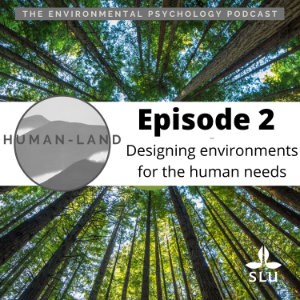Researcher Jonathan Stoltz from SLU shares his current research about how environments can be designed to cater for the human needs. We hope to inspire city designers to creatively integrate evidence-based design in their planning practices to create supportive environments for health and wellbeing.
This episode is the second in a series about how green and natural spaces can support resilient societies. We apply an Environmental Psychology perspective to understand current issues and what actions can be taken by talking to specialists and practitioners in the relevant fields. In this episode, we explore the design of supportive environments by learning about the theoretical framework of the Perceived Sensory Dimensions, where we discuss perceived important qualities of outdoor spaces for health and wellbeing and how this evidence could be applied in the design of sustainable cities.
In this episode, Amanda Gabriel is in conversation with Jonathan Stoltz who has been producing research with the Department of People and Society at SLU on perception in relation to human health and wellbeing to promote the development of evidence-based planning.
The UN has proposed the 2030 Agenda for sustainable development which includes goals for sustainable urban environments and communities and the promotion of wellbeing for all. Despite a growing body of scientific research about supportive environments to cater for the human needs, an issue for the implementation is the current tension in values in the development of urban cities between the need of densification and sustainable solutions. Creating supportive environments has also a certain complexity because there is a need of a nuanced understanding of which are the important perceived qualities of environments to find a balance in design to promote health. The core of this problem concerns the difference between what is perceived and the physical dimensions in environments. This is something that an Environmental Psychology perspective can help to balance.
This podcast explores:
• A framework for evidence-based planning, with the Perceived sensory dimensions as a currently evolving theoretical understanding about the perceived environmental qualities that are supportive for the human needs for the outcome of health.
• The implications and the operationalisation of this theoretical framework as a balance between qualitative and quantitative approaches, where the compatibility between factors can be a practical way of implementing these evidence-based dimensions into design.
• We explore the needs for the sustainable development of cities with a health perspective.
We hope you enjoy exploring this topic with us and we hope this is an opportunity to inspire urban planners!
Play the episode on Spotify:
Play the episode on Soundcloud:
